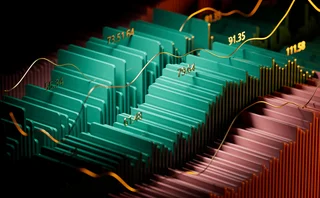
Fixed income in 2023: Mergers, modernization, and mysteries, oh my!
Between tech revolutions, secret EMSs and electronified bonds, the fixed-income market saw major advancements over the last 12 months
Each year, our coverage of the fixed income markets consists of stories about slow steps toward electronification; pragmatic acquisitions of smaller, well-run organizations by the giants in the space; and start-ups finding new ways to automate manual processes. The vastness of the fixed-income market and the perennial issues it faces means that the fixed-income market essentially operates on a different time stream from other asset classes. It’s like the period between Christmas and New Year’s Day when no one knows what day it is.
As our editor-in-chief Anthony Malakian noted in his column earlier this year, our reporting on fixed income electronification efforts extends back decades, and while there has been some forward movement since then, the market is still so fragmented that a rising tide has not lifted all boats. Separating the bluster from tangible results happening on the bleeding edge is crucial to working out fixed income’s measurable progress toward something closer to full electronification.
In 2023, as we’re entering 2024, there are still clients that pick up the phone and do trades like it’s 1994
Billy Hult, Tradeweb
The potential benefits of an electronified fixed income market are considerable—more accurate pricing, a clearer picture of day-to-day liquidity, and better execution—but the rate of adoption has not been as fast as anticipated, and the structure of most trades has remained unchanged for almost 30 years. As Tradeweb CEO Billy Hult said in the company’s third-quarter earnings call, “In 2023, as we’re entering 2024, there are still clients that pick up the phone and do trades like it’s 1994.”
Spencer Lee, chief markets officer and head of fixed income at TS Imagine, told WatersTechnology in July of this year that increased buy-side awareness will drive increased adoption of automation.
“The buy-side fixed-income community is trying to realize what is possible and achievable. Some players are undoubtedly utilizing AI and automation well, but the majority is still figuring it out,” said Lee.
New technologies seeping into fixed income—chiefly large language models (LLMs) and machine learning—also present opportunities for continued innovation. Algorithms and AI systems ingest behavioral trading data alongside huge amounts of historical data to generate bond prices. This is also cutting down the number of high-touch interactions for human traders, allowing them to focus on more specific trades. Apu Shah, partner at 28Stone Consulting, told WatersTechnology in July, “It’s really a question of ‘shove it in the algo [and] if the algo says it’s worth trading, trade it.’ That gives the human traders the time to focus on the higher-value trades.”
Smaller players in the fixed-income space looking for breathing room in a market dominated by Bloomberg, Tradeweb, and MarketAxess are going all in on these newer technologies. Broadridge’s bond trading platform LTX rolled out its generative AI-backed tool BondGPT, build on OpenAI’s GPT-4 LLM.
The tool leverages generative AI to answer traders’ questions about corporate bonds and price identification, and queries about the market. The answers received can be delivered in the form of charts, tables, or in text form—and these answers are delivered fast. LTX CEO Jim Kwiatkowski told WatersTechnology in November that in the 95th percentile, BondGPT answers in less than 20 seconds.
Kwiatkowski recognizes that breaking into the fixed-income market is challenging, but said innovation is key in the struggle to compete with established companies for trader screen real estate.
“There are other trading platforms, and we entered a space looking to differentiate ourselves in a couple of ways. But there’s no denying that as a new trading platform, you need to earn desktop screen real estate. BondGPT has helped us do that,” Kwiatkowski said. “Now we are being asked to build on the foundation that we came up with [for] BondGPT, so getting us a permanent place on our customers’ desktops helps us to earn trading volume.”
Shopping for presents … and buyers
As my colleague Theo Normanton wrote in August of this year, low volatility squeezes trading volumes, so the major fixed-income venues are turning to new data products and automation tools to drive more traffic to their platforms and grow market share.
This year was an important one for mergers and acquisitions in the fixed-income space. In March, Bloomberg announced that it had decided to acquire trading technology provider Broadway Technology to bolster customer access to the rates and credit markets.
Broadway re-emerged in 2020 after a complicated deal with Ion Group. Initially, Broadway had been consumed by Ion, effectively eliminating its closest competitor in fixed-income trading technology and prompting questions about fairness from market participants. Eventually, Ion was forced to spin off Broadway’s fixed-income franchise, while keeping its FX side. Three years later, the company’s dedication to fixed-income tech drew the interest of Bloomberg.
Bloomberg was not alone in its desire to shop around for promising fixed-income talent this year. In the same month that the Broadway acquisition was reported, Chicago-based futures trading software provider Trading Technologies (TT) announced that it had acquired fixed-income trading system vendor AxeTrading. The deal took TT into the corporate and government bond markets, and, mirroring the Bloomberg–Broadway deal, was an instance of a large company picking up a smaller, high-performing one to expand its multi-asset offering.
Prior to acquiring AxeTrading, TT had been known as a derivatives specialist, but CEO Keith Todd told WatersTechnology that the company’s roots in the space were deep enough that it was prepared to expand across asset classes, and indicated that fixed income was just the beginning.
“It was natural to expand. The announcement of the Axe acquisition is the first material step into another asset class,” Todd said. “This isn’t the end of the journey; this is merely the beginning of moving into multi-asset. There’s FX to follow, and securities in time.”
In April, capital markets risk management vendor Numerix got in on the M&A action, acquiring Fincad, a financial derivatives and fixed-income pricing and risk analytics company. As a fixed-income specialist, Fincad shored up Numerix’s fixed-income offering, and is set to be fully integrated into its parent company, as opposed to being run as a standalone service.
Fixed income now may look like equities 25 years ago in terms of electronification, but it’s advancing rapidly. Asset class doesn’t really matter—both the buy and sell side consistently cite ease of use, reliability, and high-quality support as the most important attributes of trading technology
Jesse Forster, Coalition Greenwich
On August 7, MarketAxess bought multi-asset algorithmic trading technology provider Pragma in another example of a big player in fixed-income striking a deal to buy an enterprising high-performer. In acquiring Pragma, a vendor with a strong history of creating algorithms for equities and FX, MarketAxess was banking on the strength and speed of fixed-income electronification, believing that the proliferation of data that comes with higher velocity markets would give algorithms a central role in fixed income, too.
Jesse Forster, head of equity market structure and technology at Coalition Greenwich, told WatersTechnology that the knowledge and contacts that Pragma had built up in FX and equities would be valuable to MarketAxess in fixed income as the market evolves.
“Fixed income now may look like equities 25 years ago in terms of electronification, but it’s advancing rapidly. Asset class doesn’t really matter—both the buy and sell side consistently cite ease of use, reliability, and high-quality support as the most important attributes of trading technology. Leveraging organizations like Pragma that have deep experience in the electronic evolution in equities, will be vital,” Forster said.
Squeezing the orange
For one company, the word on the street is that it is not looking for something to buy, but rather someone to buy it. WatersTechnology Emea editor Rebecca Natale first got a tip in April of this year that Ion Markets was potentially on the lookout for a new owner, and over the next four months, WatersTechnology spoke with more than a dozen industry participants, eight of whom repeated the rumor that Ion was potentially looking for one or more buyers.
The list of potential buyers for a company as large as Ion Markets is short, in that it would have to be a mega-vendor or market infrastructure provider with a high market cap. Three names that match that description are the aforementioned major fixed-income trading platforms—Bloomberg, Tradeweb and MarketAxess—all of which teamed up earlier this year to work on constructing a consolidated tape for the European bond market (which has since fallen apart).
If Bloomberg were to throw its hat into the ring, it would reunite Ion with Broadway Technology, but that deal could raise the same regulatory concerns about market competition that hindered the original Broadway–Ion deal. While Ion’s precise valuation is hard to discern—the most up-to-date public information stems from a February 2023 interview in an Italian newspaper—acquiring Ion would give its buyer a significant edge over its two fervent competitors.
A former Refinitiv employee who spoke to WatersTechnology for that story said that it could be tricky to persuade a potential buyer that Ion Markets is worth such a significant investment of resources.
“If you’re acquiring this company, you have to wonder if all the juice has been squeezed out of this orange,” the ex-Refinitiv employee said. “Can you extract any more value from it? And if these different products have been underinvested in, are you going to have to spend a lot more money to get them up to your standards, modernize it and get it back to state-of-the-art?”
Letting the genie out of the bottle—a bit
BlackRock’s Aladdin, a buy-side-focused multi-asset portfolio analysis tool, has been lauded by portfolio managers and hedge funds for its depth of analysis, adaptability to market changes and continual updates. Therefore, talk of an upcoming upgrade or add-on to Aladdin, which our Asia editor Wei-Shen Wong heard about more than 18 months ago, is a big deal. On LinkedIn, multiple past and present BlackRock employees are listed as working on a service called “Aladdin Trader,” yet at the time of publication there is no product of that name anywhere on BlackRock's website.
Aladdin Trader is an internal project—maybe more an internal-like protocol. But you wouldn’t find Aladdin Trader on the website. Aladdin is an expensive product, right? And it has many modules that firms just wouldn’t hear about in any way as they’re proprietary and not sold separately
Current BlackRock employee
After 18 months of research by Tony Malakian, Wei-Shen Wong and former WatersTechnology reporters Joanna Wright and Josephine Gallagher, who spoke to more than three dozen fixed-income trading experts, involving conversations that had taken place across three continents, WatersTechnology published an article breaking the news that BlackRock was working on a kind of execution management system (EMS)—although that is not what the firm is calling it.
“Aladdin Trader is an EMS functionality built within the OMS. We can’t sell Aladdin Trader to someone who doesn’t use Aladdin. So, someone who uses Aladdin can use the EMS functionality; it’s just embedded in the OMS,” said a current BlackRock employee. “It’s an internal project—maybe more an internal-like protocol. But you wouldn’t find Aladdin Trader on the website. Aladdin is an expensive product, right? And it has many modules that firms just wouldn’t hear about in any way as they’re proprietary and not sold separately.”
A head of fixed-income trading at a European asset manager that uses Aladdin described a demo they saw of Aladdin’s “direct execution facility” as having “very basic” execution functionality—and in a field competing against established multi-asset EMSs like Virtu’s Triton, FlexTrade, and FactSet’s Portware, this could be a concern for BlackRock.
Some sources spoken to for the story said they would have preferred more quality-of-life changes from BlackRock, as opposed to reinventing the wheel with an EMS.
“We’d rather they put their capabilities into that core functionality rather than trying to build new trading capabilities. For some small funds, it might be better to have it all in one place, but we want a huge amount of detail in our EMS. … The thing is, they are trying to break into a market that already works very well for us and the barriers to entry are quite high,” said a head of trading at a UK asset manager.
For now, Aladdin Trader remains shrouded in secrecy, but perhaps more will be revealed in 2024.
Only users who have a paid subscription or are part of a corporate subscription are able to print or copy content.
To access these options, along with all other subscription benefits, please contact info@waterstechnology.com or view our subscription options here: http://subscriptions.waterstechnology.com/subscribe
You are currently unable to print this content. Please contact info@waterstechnology.com to find out more.
You are currently unable to copy this content. Please contact info@waterstechnology.com to find out more.
Copyright Infopro Digital Limited. All rights reserved.
As outlined in our terms and conditions, https://www.infopro-digital.com/terms-and-conditions/subscriptions/ (point 2.4), printing is limited to a single copy.
If you would like to purchase additional rights please email info@waterstechnology.com
Copyright Infopro Digital Limited. All rights reserved.
You may share this content using our article tools. As outlined in our terms and conditions, https://www.infopro-digital.com/terms-and-conditions/subscriptions/ (clause 2.4), an Authorised User may only make one copy of the materials for their own personal use. You must also comply with the restrictions in clause 2.5.
If you would like to purchase additional rights please email info@waterstechnology.com
More on Trading Tech
Recent volatility highlights tech’s vital role in fixed income pricing
MarketAxess’ Julien Alexandre discusses how cutting-edge technology is transforming pricing and execution in the fixed income market amid periodic bouts of volatility
Banks fret over vendor contracts as Dora deadline looms
Thousands of vendor contracts will need repapering to comply with EU’s new digital resilience rules
Where have all the exchange platform providers gone?
The IMD Wrap: Running an exchange is a profitable business. The margins on market data sales alone can be staggering. And since every exchange needs a reliable and efficient exchange technology stack, Max asks why more vendors aren’t diving into this space.
This Week: Trading Technologies completes ANS deal; State Street; Equinix; and more
A summary of the latest financial technology news.
Interactive Brokers looks beyond US borders for growth opportunities
As retail trading has grown in volume and importance, Interactive Brokers and others are expanding international offerings and marketing abroad.
JP Morgan’s goal of STP in loans materializes on Versana’s platform
The accomplishment highlights the budding digitization of private credit, though it’s still a long road ahead.
As data volumes explode, expect more outages
Waters Wrap: At least for those unprepared—though preparation is no easy task—says Anthony.
This Week: ICE Bonds and MarketAxess plan to connect liquidity networks, TS Imagine, Bloomberg, and more
A summary of the latest financial technology news.








